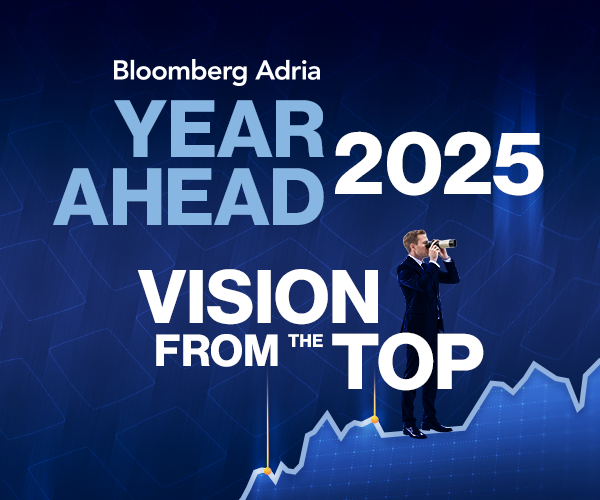In 2025 we expect positive effects to come from falling interest rates which will speed up the investment cycle on both the regional and EU front. We see infrastructure investments to keep making positive contribution to the GDP growth, as well as services exports. The consumption contribution will still be positive, but slower compared to 2024, due to the buildup base and slower rise in wages.
The Adria region has been a solid ground for foreign investments in recent years. Support for further demand lays in the positive FDI inflows, providing higher potential for production and later exports. However, the stalling growth in Europe has been spilling over to the Adria region economies. The external demand has been weak and mostly a limiting growth factor in 2024, as all the economies in the region experienced deepening deficit in goods trade. Aside from the fact that the region is geographically good positioned in Europe and that Slovenia and Croatia are a part of the EU, the main factors making the region attractive stem from the labour market. This is particularly true in the non-EU part of the region. The availability of labour force and lower labour costs suit investors, as well as incentives aiming to attract foreign investors (such as free zones and logistics parks investments). We see this trend continuing as Europe deals with aging population and labour force shortfalls.
We shouldn’t skip the position of the region regarding energy, especially after the 2022 mess. The gas flows have been diversifying, aiming to increase stability of the supply side. The step up is seen in the development of sustainable electricity sources, so production of solar and wind farms is giving better results. Further investments (many already announced and supported by foreign development banks) in renewable energy capacities give foundation for better sustainability profile in the future. We expect gas prices in the European market to be around 35 EUR/MWh in 2025. Demand remains relatively weak, partly due to an expected mild winter and lower industrial consumption, with gas demand in Europe around 20% below 2021 levels. Additionally, solar and wind generation help to ease pressure on gas demand. Risks primarily stem from geopolitical tensions that could disrupt supply routes and increase price volatility. For electricity prices on the German exchange, we also anticipate minimal upward pressure. There is even the potential for "cannibalization," where electricity prices decline—occasionally turning negative—on days with strong solar and wind production that lead to excess supply. Regarding the oil price, we expect Brent oil to move around USD 75 per barrel. China's fiscal stimulus had no effect on oil price growth so far. Also, the growth of deliveries of electric vehicles and the reduction of the production of diesel vehicles, reduce the demand in China for oil (-4% yoy). On the other hand, the disputes in the Middle East as well as the uncertainty related to the export of oil from Libya put pressure on the increase in oil prices, but to a lesser extent.
Inflation in the two-digit zone is left behind, but stubborn rise in services prices and uncertainties around food prices are issues to look at in 2025. Services prices have been pushed by good demand, coming from both domestic side (strong real wage growth) and better tourist inflows and rising labour costs. When wages go up in real terms, consumption of services benefits more than consumption of goods lifting demand and the prices. The services inflation is showing persistence, but we see it as a normalization of the structure, as services were leading the inflation rates in the pre pandemic period. We see food prices to be the source of uncertainty in the following year, regarding inflation. Increased occurrence of unfavorable weather events is the main driver and something that is hardly manageable but affecting domestic and global production. Dry weather in Brazil is pumping up sugar prices, while drought in the region pushes fresh fruit prices.
In mid-2024, the ECB began easing restrictive monetary policy by cutting reference interest rates. The 3M Euribor, which closely follows ECB policy, is currently at 3%. In 2025, we expect the ECB to continue lowering the deposit rate to 2%, which should also bring the 3MEuribor down to this level, conversely leading to lower interest rates for the economy. With inflation anchored and gradually losing its dominance in ECB decision-making, we now anticipate a greater focus on labour market dynamics and broader economic conditions, particularly in the industrial sector. The manufacturing confidence index (PMI) remains below 50, with Germany's PMI even lower, both still in contraction territory. Despite relatively low eurozone unemployment at 6.4%, some industrial companies—especially German ones like BASF, Thyssenkrupp, and Volkswagen—have announced workforce reductions. This could ease labour market pressure, temper wage growth expectations and further alleviate inflationary pressures. German government frictions and potential geopolitical shocks pose the biggest risk of inflation resurfacing as a priority, though this is not our primary case now. We also expect the NBS and the NBRNM to align with the ECB's policy, releasing additional liquidity into their respective systems. This should facilitate corporate and consumer borrowing, driving investment cycles in both Serbia and North Macedonia.
Regarding capital markets, the election of the new US president has given a strong boost to global capital markets. We expect positive trends to persist, driven particularly by advances in AI, infrastructure projects and increased global defense spending. In the Adria region, we anticipate a similar trajectory in 2025, supported by solid economic growth. Equity indices in the region (excluding BH) are likely to continue rising, fueled by favorable macroeconomic indicators. However, this growth may be moderate due to elevated valuations, especially in North Macedonia and Croatia. In Q32024, many listed companies surpassed last year's performance, which should positively influence index performance. Key sectors driving this growth include green transition initiatives, construction and banking. The banking sector is expected to still benefit from a sustained gap in net interest margins, with lending rates outpacing deposit interest rates. Meanwhile, ongoing infrastructure projects and inflows of EU funds remain crucial for the construction and green transition sectors. We remain underweight on defensive sectors such as energy, given the lower energy prices compared to last year. Additionally, we hold a neutral stance on the tech sector due to its current valuations.
In the bond market, we foresee a continued, gradual decline in yields, a trend that began mid-year of 2024. This is supported by central banks lowering interest rates and reducing risk premiums. Serbia’s recent investment-grade rating from S&P is also likely to be matched by upgrades from the other two major credit rating agencies in the coming months. These upgrades, along with projected interest rate cuts by the NBS are expected to ease the cost of future debt issuances. Croatia’s A- rating and Serbia’s investment-grade rating make both countries more attractive to funds and investors previously limited by restrictive investment rules, potentially driving further yield reductions. So, for 2025, we expect a slight decrease in interest costs as a share of GDP, decreasing an average of 1.5% in the Adria region. The interest payment burden remains relatively low, indicating that the countries in the region are not heavily burdened by interest payments.













.png)